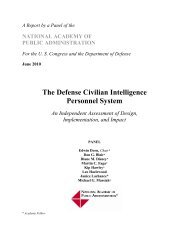New San Francisco Federal Building a Model of Sustainable ...
New San Francisco Federal Building a Model of Sustainable ...
New San Francisco Federal Building a Model of Sustainable ...
- No tags were found...
You also want an ePaper? Increase the reach of your titles
YUMPU automatically turns print PDFs into web optimized ePapers that Google loves.
educing the urban heat-island effect that adversely affects the local climate <strong>of</strong> urban<br />
environments. Surface parking would have also been an eyesore for local businesses<br />
and the community.<br />
Prior to becoming new building materials, over 13% <strong>of</strong> the total value <strong>of</strong> construction<br />
material on the project was post-consumer or post-industrial waste.<br />
During construction, over 90% <strong>of</strong> construction waste was diverted from landfill<br />
through on-site separation, saving about $1.3 million in potential dumping fees.<br />
At least 50% <strong>of</strong> all electricity purchased in the building will come from renewable<br />
energy sources like wind or solar power.<br />
Approximately 50% <strong>of</strong> the Portland<br />
cement used in the concrete is blastfurnace<br />
slag, which is a by-product <strong>of</strong><br />
steel manufacturing. Substituting blastfurnace<br />
slag in concrete not only<br />
sequesters the pollutant from the<br />
environment, but reduces the amount <strong>of</strong><br />
Portland cement needed to be produced to<br />
build the building. For every ton <strong>of</strong><br />
cement generated, one ton <strong>of</strong> CO2 is<br />
released into the atmosphere. As a result,<br />
approximately 5,000 tons <strong>of</strong> CO2 were<br />
effectively prevented from being released<br />
into the atmosphere.<br />
Since July 2007, 18.3 tons <strong>of</strong> mixed paper<br />
were recycled.<br />
In conclusion, the new <strong>San</strong> <strong>Francisco</strong> <strong>Federal</strong><br />
<strong>Building</strong> helps define the notion <strong>of</strong> what<br />
sustainable buildings are and can be. The<br />
building features many well-known, highly-integrated, tried-and-true green-building<br />
techniques that render significant energy, water, and material efficiencies. It proves how a<br />
building can sustain and even improve peoples’ health and livelihoods not only within the<br />
building, but beyond its walls as well. As the building nears its first full year <strong>of</strong> occupancy,<br />
GSA is keenly studying its performance. The building was designed to consume one-third the<br />
energy <strong>of</strong> a typical California <strong>of</strong>fice building, approximately 30,000 BTUs per square foot<br />
per year. The total estimated utility-bill savings to the Government as a result are<br />
approximately $500,000 per year. If the building performs as designed, it will save enough<br />
energy - 6.9 million kilowatt hours - to power 600 homes or take 830 cars <strong>of</strong>f the road for one<br />
year. Another way <strong>of</strong> putting it is that the reduced energy to run this building will prevent the<br />
potential release <strong>of</strong> about 8,150 tons <strong>of</strong> greenhouse gas emissions into the atmosphere per<br />
year. Moreover, we estimate that the Government will save approximately $500,000 a year<br />
on utility bills. Whatever the actual numbers, the new <strong>San</strong> <strong>Francisco</strong> <strong>Federal</strong> <strong>Building</strong> will be<br />
the topic <strong>of</strong> discussion, in terms <strong>of</strong> architectural beauty, sustainable performance and<br />
community improvement, for years to come.













